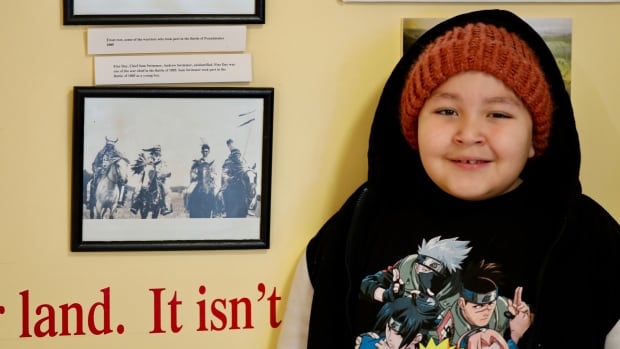
How culture, ancestral connection and passion make these 3 western Sask. communities feel like home
CBC
CBC's virtual road trip series Land of Living Stories explores the hidden gems across Saskatchewan. Reporter Laura Sciarpelletti once again hit the road in search of inspiring stories of community, heritage and good food.
If we've learned anything over the course of this series, it's the power of a small town. Tight-knit communities offer opportunities to develop deep bonds with neighbours, the land and the small businesses that keep the towns running.
This time, CBC is taking you to the intimate communities of Kerrobert, Unity and Poundmaker Cree Nation for stories of finding home and safety, how a building can be the focal point for many generations of residents and how a home-grown museum is sprouting pride in the youngest members of a First Nation.
Before even entering the town limits, visitors to Kerrobert — 188 kilometres west of Saskatoon — are greeted by a large barn covered with many colours and many names. Community volunteer Bobbi Hebron says they're the names of Kerrobert's most recent high school graduates. The 'grad barn' is a long-standing tradition.
"I believe it was in the '60s or '70s that the tradition was started that the graduates paint their name on the barn. It started out that the farmer must have agreed to allowing it to happen. In fact, it might have even been his kids that started it. So it still continues to this day," Hebron said with a laugh, recalling that her own grad painting job was blue.
Kerrobert's population hovers just above 1,000, and its history is as colourful as the grad barn. That's largely thanks to the town's prized possession, the century-old Kerrobert Courthouse. Hebron calls it the focal point of the community, and for good reason. Although it no longer functions as a courthouse, it houses a museum, gallery, library and numerous businesses, and is also where town council meets.
Hebron has lived in Kerrobert, a farming and oil-field community, for most of her life, and said she's always known the courthouse was a special place.
"There was a sense of pride that I had because my great grandmother worked there. She was one of the first women to work in the courthouse. So I had a real love for the building from an early age."
As a child, Hebron and the other kids hung out at the courthouse and on its front steps — something today's generation does as well.
Another draw is the ghost stories. The Kerrobert Courthouse is considered by many to be one of the most haunted buildings in Saskatchewan. The 1920 neo-classical architecture styled-building once had jail cells in the basement, and Hebron said some people believe those rooms may hold some angry spirits to this day.
"As a kid, sometimes you had to be dared to even walk through it, especially at night. And as we got older, we got braver. At about 12 years old you were brave enough to maybe play hide and seek for a little bit," she said.
Visitors can also view the contents of a 102-year-old time capsule that was dug up from under the courthouse steps in 2022. Hebron said seeing pictures, newspapers and documents from when the courthouse was first built was a thrill of a lifetime.
"You have to drive pretty far to find a lot of that type of history and architecture in rural [Saskatchewan]. We've brought a lot of culture, I feel, to the community."
Brandy Osterhold, who has lived in Kerrobert for most of her life, said the beauty of the town is in its people and how close they are.





















 Run 3 Space | Play Space Running Game
Run 3 Space | Play Space Running Game Traffic Jam 3D | Online Racing Game
Traffic Jam 3D | Online Racing Game Duck Hunt | Play Old Classic Game
Duck Hunt | Play Old Classic Game